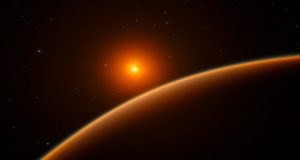
مطالعه جدید دانشمندان دانشگاه تگزاس در ال پاسو نشان می دهد، ۱۰۰ میلیون سیاره فقط در کهکشان راه شیری وجود دارد که می توانند از اشکال پیچیده حیات پشتیبانی کنند. چالش پیش روی دانشمندان مسافت بسیار دور آنها با ما است.
دانشمندان یک روش محاسباتی جدید را برای بررسی دادههای سیارات فراخورشیدی ارائه دادند که اولین برآورد کمی از تعداد سیارات با قابلیت میزبانی از حیات بالاتر از سطح میکروبی را ارائه میکند. لوئیس ایروین، سرپرست این مطالعه و استاد ممتاز بازنشسته در دانشگاه تگزاس در ال پاسو اظهار داشت: “از یک طرف، بعید به نظر می رسد که ما تنها باشیم ، اما از سوی دیگر، به نظر نمی رسد که در این سیارات حیات پیچیده ای مثل زمین وجود داشته باشند و حیات در سطح میکروبی وجود دارد. ”
این مطالعه عنوان نمیکند که اشکال پیچیده حیات در سیارات مختلف وجود دارند، بلکه شرایط سیارهای آنها امکان میزبانی از حیات احتمالی را تقویت میکند. دانشمندان این رقم را پس از بررسی بیش از ۱،۰۰۰ سیاره فرا خورشیدی و از یک فرمول برای سنجش چگالی، دما، شیمی، سن و فاصله سیاره تا ستاره مادری اش بدست آوردند. از این رو، تیم ایروین این فرمول را (BCI) یا “شاخص پیچیدگی حیات” اعلام کردند. این شاخص در رتبه “تعداد و درجه ای از ویژگی های در نظر گرفته برای حمایت از اشکال گوناگون زندگی چند سلولی مهم است،” این تیم تحقیقاتی اظهار داشت، با وجود ۱۰ میلیارد ستاره در کهکشان راه شیری، به طور متوسط برای هر یک ستاره یک سیاره در نظر گرفته شده است که طبق شاخص ،حدود ۱۰۰ میلیون سیاره می تواند از حیات پیچیده برخوردار باشد.
طبق محاسبات، این شاخص نشان می دهد که یک تا دو درصد سیارات از نسبت بالاتر”شاخص پیچیدگی حیات” در مقایسه با “اروپا” قمر مشتری برخوردارند که احتمالا دارای حیات میکروبی در زیر یخ ها و اقیانوس زیر سطحی آن میباشد. البته هیچ تضمینی وجود ندارد که زندگی پیچیده در هر یک از این مکان ها وجود دارد داشته باشد و در نهایت منجر به شکل گیری حیات به پیچیدگی زمین و موجودات زنده شود. همچنین، این محققان اضافه کردند اشکال پیچیده حیات به معنای موجودات هوشمند فرازمینی نیست، بلکه شامل ارگانیسمهایی بزرگتر و پیچیدهتر از میکروب میباشد، سیارات شناخته شده با “شاخص پیچیدگی حیات” بسیار از ما دور هستند. یکی از نزدیک ترین سیستم های فرا خورشیدی Gliese581 است که ۲۰ سال نوری از ما فاصله دارد و ۲ سیاره در اطراف خود دارد که احتمالا از حیات پیچیده ی میکروبی برخوردار است.
منبع : upr
100 Million Planets in our Galaxy May Harbor Complex Life
One Percent of All Exoplanets May Be Suitable for Complex Organisms
The number of planets on which complex life could exist in the Milky Way may be as high as 100 million, according to a study published this week by two former University of Texas at El Paso (UTEP) professors and their colleagues in the on-line journal, Challenges.
“This constitutes the first quantitative estimate of the number of worlds in our galaxy that could harbor life above the microbial level, based on objective data,” according to the lead author of the peer-reviewed study, Dr. Louis Irwin, Professor Emeritus and former Chair of Biological Sciences at UTEP.
Irwin and his colleagues surveyed the growing list of more than a thousand known exoplanets (planets in other solar systems). Using a formula that considers planetary density, temperature, substrate (liquid, solid, or gas), chemistry, distance from its central star, and age, Irwin’s team computed a “biological complexity index (BCI)”, which rates planets on a scale of 0 to 1.0 according to the number and degree of characteristics assumed to be important for supporting multiple forms of multicellular life.
The BCI calculation revealed that 1 to 2 percent of exoplanets showed a BCI rating higher than Europa, a moon of Jupiter thought to have a subsurface global ocean which could harbor different forms of life. Based on a very conservative estimate of 10 billion stars in the Milky Way Galaxy, and assuming an average of one planet per star, this yields the figure of 100 million. It could be over 10 times higher if we consider a larger number of stars in our galaxy.
Irwin emphasized that the study does not indicate that complex life exists on that many planets – only that the planetary conditions that could support it do. He also noted that complex life doesn't mean intelligent life (though it doesn't rule it out), or even animal life, but simply that organisms larger and more complex than microbes could exist in a number of different forms, quite likely forming stable food webs like those found in ecosystems on Earth.
“Other scientists have tried to make educated guesses about the frequency of life on other worlds based on hypothetical assumptions, but this is the first study that relies on observable data from actual planetary bodies beyond our solar system,” Irwin said.
Despite the large absolute number of planets that could harbor complex life, the Milky Way is so vast that, statistically, planets with high BCI values are very far apart. One of the closest and most promising extrasolar systems, known as Gliese 581, has possibly two planets with the apparent capacity to host complex biospheres, yet the distance from the sun to Gliese 581 is about 20 light years. One light year is the distance that light travels in one year.
Most planets with a high BCI are much further away. If the 100 million planets that Irwin’s team says have the theoretical capacity for hosting complex life were randomly distributed across the galaxy, they would average about 24 light years apart.
“On the one hand,” according to Irwin, “it seems highly unlikely that we are alone. On the other hand, we are likely so far away from life at our level of complexity, that a meeting with such alien forms is extremely improbable for the foreseeable future.”
Co-authors of the study include Dirk Schulze-Makuch, formerly an Associate Professor of Geological Sciences at UTEP, now at Washington State University, Alberto Fairén of Cornell University, and Abel Méndez, of the University of Puerto Rico at Arecibo.
Two years ago, these same scientists were part of the team that published an “Earth Similarity Index (ESI)”, which rates exoplanets also on a scale of 0 to 1.0 according to how similar they are to Earth.
Not surprisingly, higher BCI values tend to be correlated with higher ESI values, but there are some exceptions. “Planets with the highest BCI values tend to be larger, warmer, and older than Earth,” said Irwin, “so any search for complex or intelligent life that is restricted just to Earth-like planets, or to life as we know it on Earth, will probably be too restrictive.”
 گجت نیوز آخرین اخبار گجتی و فناوری های روز دنیا
گجت نیوز آخرین اخبار گجتی و فناوری های روز دنیا 





